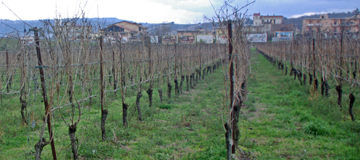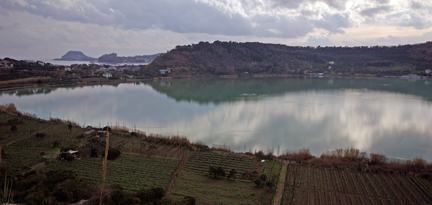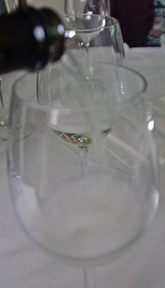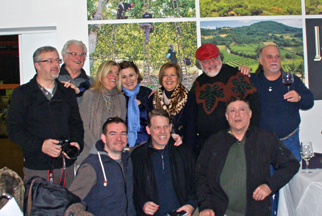Grotta del Sole
by
Kathy Sullivan
 Summary: Grotta del Sole is a unique winery located close to Lake Avernus. Some of the vineyards are located on the slopes leading to Lake Avernus on the Bay of Naples, a lake that was once know as one of the Gates of Hell. The name for the winery comes from an oriental wine legend.The winery opens for one visitor or a group.
Summary: Grotta del Sole is a unique winery located close to Lake Avernus. Some of the vineyards are located on the slopes leading to Lake Avernus on the Bay of Naples, a lake that was once know as one of the Gates of Hell. The name for the winery comes from an oriental wine legend.The winery opens for one visitor or a group.
Grotta del Sole winery is a family-owned winery. The Martusciello family named the winery Grotta del Sole because it means Cave of the Sand and Sun. The name comes from an oriental legend about a man who made wine in a cave. He lived in the cave and asked the sun to protect the wine when he needed to leave the cave. The sun was chosen because it could not enter the cave.
 Grotta del Sole is located near Naples, Italy where visitors can find a sense of history together with modern winemaking. A view of Lake Avernus that was enclosed from the Bay of Naples by a 1534 volcano provides a stunning view of vineyards nestled next to it. The lake is also known for Roman ruins below the water. At the time of the Romans, ships were kept at the lake because they could not be seen from the bay. The area is sometimes referred to as the Gates of Hell because at one time it was thought that birds would not fly across the lake for fear of death. Travelers can drive along Via Montenuovo Licola Patria and park along the observation areas. There are stunning views of the lake, vineyards and nearby volcano.
Grotta del Sole is located near Naples, Italy where visitors can find a sense of history together with modern winemaking. A view of Lake Avernus that was enclosed from the Bay of Naples by a 1534 volcano provides a stunning view of vineyards nestled next to it. The lake is also known for Roman ruins below the water. At the time of the Romans, ships were kept at the lake because they could not be seen from the bay. The area is sometimes referred to as the Gates of Hell because at one time it was thought that birds would not fly across the lake for fear of death. Travelers can drive along Via Montenuovo Licola Patria and park along the observation areas. There are stunning views of the lake, vineyards and nearby volcano.
The winery is close by and while they do not have a typical tasting room, a generous size event room inside the winery allows for the pouring of wines. It was noted, “We’ll open the winery for one person.”
In 2006, while increasing the size of a vineyard, Grotta del Sole discovered a Roman rural villa on their property. Estimates are that the villa was built between the 2nd BC and 1st BC. Among the discoveries made was an amphora that was in excellent condition. In addition, a wine cellar was discovered leading some to believe wine had been made there.
Six vineyard areas are used for producing Grotta del Sole wines. All of these vineyards are in the Campania region with Naples in the center. The vineyards include Aversa, Campi Flegrel, Fiano di Avellino, Greco di Tufo, Penisola Sorrentina and Vesuvio.The company manages 120 hectares (almost 300 acres) of vineyards. In the vineyards an ancient trellising system, Alberato, dating back to the Etruscans is used. Alberato means “married to poplar trees.” Grapevines are planted growing up poplar trees. During the season pruning is done on both the tree and grapevine. Tall, thin ladders lean against the trees for harvesting grapes.
 Grotta Del Sole Wines
Grotta Del Sole Wines
Gilda Martusciello discussed the winery. She showed a slide show and commented about the Grotta Del Sole wines. Malia was an extra dry sparkling wine made of the grape Falanghina. It was a very light straw color, refreshing and crisp. Coste de Cuma 2010 was 100 percent Falanghina. The color was light straw. The aroma and taste were floral. A slight oak influence was noticed. The wine had a creamy finish. Montegauro was produced with Piedirosso grapes. The result was a ruby wine with aromas and taste that were floral with black fruit notes. The finish was fruity with tannins.
Grotta Del Sole was the final winery of our trip and our group took the opportunity for some group photos.
When visiting Naples be sure to ask about visiting Grotta del Sole. It will be one of the highlights of your trip.
Grotta Del Sole
Via Spinelli, 80010, Quarto, Napoli, Italia
February 16, 2012


Visit these tour operators that partner with Wine Trail Traveler.
 |
||||
|
Spain and Portugal |
SmoothRed London, England, United Kingdom |
